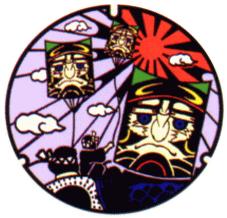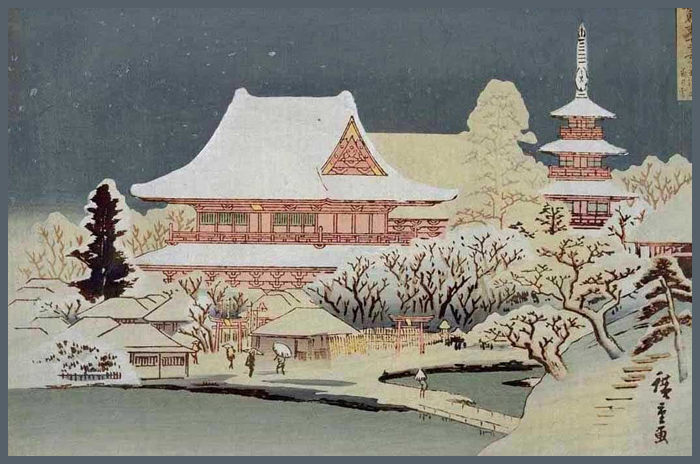. Famous Places and Powerspots of Edo 江戸の名所 .
. Persons and People of Edo - Personen .
::::::::::::::::::::::::::::::::::::::::::::::::::::::::::::::::::::::::::::::::::::::::::::::::::::::::::::::::::::::::::::::::::::::::::::::::::::::::::::::::::::::::::::::::::::
Etchuujima, Etchūjima 越中島 Etchujima district, Koto
東京都江東区 越中島一丁目から越中島三丁目 from the first to the third sub-district

The estate of the regent of the former Etchu province,
旗本榊原越中守照清 Hatamoto Sakakibara Etchu no Kami Terukiyo
was located here, hence the name.
Terukiyo was the grandchild of 榊原清政 Sakakibara Kiyomasa (1546 - 1607)
Etchujima was located in the estuary of the river Sumidagawa and was a sand bar, thus named "island".
Eventually the sand bar was lost to rain and storm and Kiyomasa gave the land back to the Edo Bakufu government.
In 1711, after more landfill, the government gave the land to 43 Hatamoto and their retainers and called it
Etchujima cho 越中島町 Etchujima district.
In 1721, other citizens came to live here.
But
In 1730, the official garbage dump of Edo at 永代島 Eitaijima was full and the government decided to make Etchujima the next one, slowly filling the shallow parts of the estuary.
In 1855, the government claimed all the landfills and established the
Koobusho 講武所 Kobusho - Academy for Military Training.
Training places for gun shooting and swimming were added.


. 越中島川 river Etchūjimagawa .
..............................................................................................................................................
東京海洋大学 Tokyo University of Marine Science and Technology
Etchujima Campus - 2-1-6 Etchujima Koto-ku, Tokyo

- HP of the University
- reference source : kaiyodai.ac.jp -
::::::::::::::::::::::::::::::::::::::::::::::::::::::::::::::::::::::::::::::::::::::::::::::::::::::::::::::::::::::::::::::::::::::::::::::::::::::::::::::::::::::::::::::::::::
Etchu no Kuni 越中国 Etchū Province

- quote -
Etchū Province (越中国 Etchū-no-kuni)
was a province of Japan in the area that is today Toyama Prefecture in the Hokuriku region of Japan.
Etchū bordered on Noto and Kaga Provinces to the west, Shinano and Hida Provinces to the south, Echigo Province to the east and the Sea of Japan to the north. Its abbreviated form name was Esshū (越州).
- History
Koshi Province (越国 / 古志国 Koshi no Kuni) was an ancient province of Japan and is listed as one of the original provinces in the Nihon Shoki. The region as a whole was sometimes referred to as Esshū (越州). In 701 AD, per the reforms of the Taihō Code, Koshi was divided into three separate provinces: Echizen, Etchū, and Echigo.
However, in 702 AD,
the four western districts of Etchū Province (Kubiki, Koshi, Uonuma and Kanbara) were transferred to Echigo Province. Etchū annexed Noto Province in 741 AD, but Noto was separated out again in 757 AD. In 746 AD, the noted poet Ōtomo no Yakamochi became Kokushi, and left many references to the region in the poetic anthology Manyōshū.
..... During the Muromachi period, the Hatakeyama clan emerged as shugo regent of the region, but preferred to remain in Kyoto, and to rule through appointed deputies, such as the Jinbō clan and the Shiina clan.
Into the Sengoku period, the Hatakeyama transferred their power base to Nanao Castle in Noto province, and Etchū became an area contested by the Uesugi clan and the Oda clan with the Ikkō-ikki helping play one side against the other. The area was eventually conquered by Oda Nobunaga's general Shibata Katsuie and his deputy Sassa Narimasa, who were later replaced by Maeda Toshiie under the rule of Toyotomi Hideyoshi.
The Maeda clan retained control of the province under Kaga Domain during the Edo period Tokugawa shogunate. During the mid-Edo period, Nei District and much of Niikawa District were separated from Kaga Domain into the 100,000 koku Toyama Domain, which was ruled by a branch of the Maeda clan.
- - - More in the WIKIPEDIA !

source : imagenavi.jp/search...
::::::::::::::::::::::::::::::::::::::::::::::::::::::::::::::::::::::::::::::::::::::::::::::::::::::::::::::::::::::::::::::::::::::::::::::::::::::::::::::::::::::::::::::::::::

source : xxx
越中国 神通川舟橋 / 冨山船橋 Boat Bridge at Toyama
Funahashi 船橋 boat bridge over the river 松川 Matsukawa.
In the Edo period, it was a famous bridge over the river Jinzuugawa 神通川 Jinzugawa, Jinzū River, built only with boats and planks.
In 1998, it was selected as 日本百名橋 one of the 100 famous bridges of Japan.
::::::::::::::::::::::::::::::::::::::::::::::::::::::::::::::::::::::::::::::::::::::::::::::::::::::::::::::::::::::::::::::::::::::::::::::::::::::::::::::::::::::::::::::::::::
. Etchu Daimon Kite Festival 越中大門凧祭り .

manhole from Daimon Town 大門町
..............................................................................................................................................
越中鵜坂社の尻たたき祭 Etchu Usakasha Shrine - shiri tataki matsuri festival
. shiritataki matsuri 尻たたき祭 "hitting the bottom"
at Iwakura town, Kyoto
::::::::::::::::::::::::::::::::::::::::::::::::::::::::::::::::::::::::::::::::::::::::::::::::::::::::::::::::::::::::::::::::::::::::::::::::::::::::::::::::::::::::::::::::::::
- - - - - H A I K U and S E N R Y U - - - - -
海の日の越中島の白帆かな
umi no hi no Etchujima no shiraho kana
all the white sails
at Etchujima
on Marine Day . . .
Tr, Gabi Greve
長谷川歌子 Hasegawa Utako
. umi no hi 海の日 Marine Day, Ocean Day .
- - kigo for late summer - -
::::::::::::::::::::::::::::::::::::::::::::::::::::::::::::::::::::::::::::::::::::::::::::::::::::::::::::::::::::::::::::::::::::::::::::::::::::::::::::::::::::::::::::::::::::

- - - To join me on facebook, click the image !
:::::::::::::::::::::::::::::::::::::::::::::::::::::::::::::::::::::::::::::::::::::::::::::::::::::::::::::::::::::::::::::::::::::::::::::::::::::::::::::::::::::::::::::::::::::
. Kōtō 江東区 Koto ward, "East River" .
. Edo bakufu 江戸幕府 The Edo Government .
. Famous Places and Powerspots of Edo 江戸の名所 .
. Doing Business in Edo - 商売 - Introduction .
. shokunin 職人 craftsman, craftsmen, artisan, Handwerker .
. senryu, senryū 川柳 Senryu poems in Edo .
. Japanese Architecture - The Japanese Home .
. Interior Design - The Japanese Home .
. Legends and Tales from Japan 伝説 - Introduction .
[ . BACK to DARUMA MUSEUM TOP . ]
[ . BACK to WORLDKIGO . TOP . ]
- - - - - #etchujima #etchujimakoto - - - -
::::::::::::::::::::::::::::::::::::::::::::::::::::::::::::::::::::::::::::::::::::::::::::::::::::::::::::::::::::::::::::::::::::::::::::::::::::::::::::::::::::::::::::::::::::



































